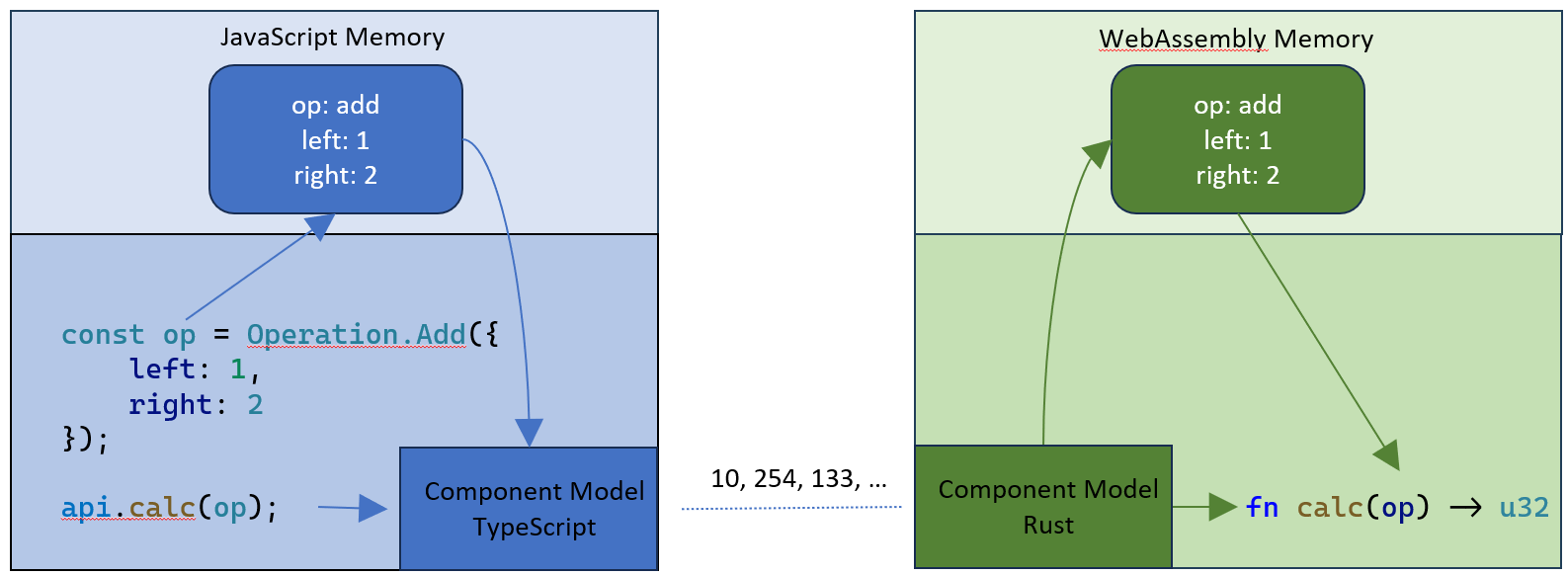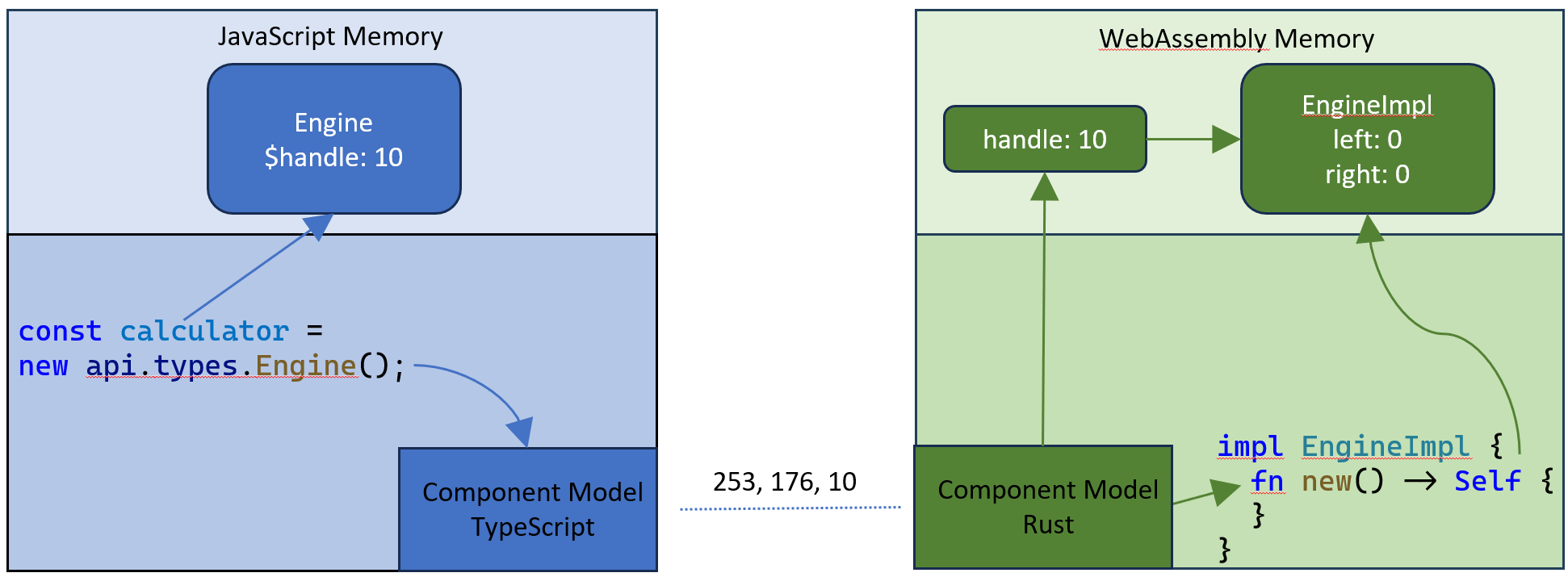使用 WebAssembly 进行扩展开发
Dirk Bäumer,2024 年 5 月 8 日
Visual Studio Code 通过 WebAssembly 执行引擎扩展支持执行 WASM 二进制文件。其主要用例是将用 C/C++ 或 Rust 编写的程序编译成 WebAssembly,然后直接在 VS Code 中运行这些程序。一个著名的例子是 Visual Studio Code for Education,它利用此支持在 VS Code for the Web 中运行 Python 解释器。这篇博客文章详细介绍了其实现方式。
2024 年 1 月,Bytecode Alliance 发布了 WASI 0.2 预览版。WASI 0.2 预览版中的一项关键技术是 组件模型。WebAssembly 组件模型通过标准化接口、数据类型和模块组合,简化了 WebAssembly 组件与其宿主环境之间的交互。这种标准化通过使用 WIT(WASM 接口类型)文件来促进。WIT 文件有助于描述 JavaScript/TypeScript 扩展(宿主)与用 Rust 或 C/C++ 等其他语言编写的执行计算的 WebAssembly 组件之间的交互。
这篇博客文章概述了开发人员如何利用组件模型将 WebAssembly 库集成到他们的扩展中。我们关注三个用例:(a) 使用 WebAssembly 实现库并从 JavaScript/TypeScript 中的扩展代码调用它,(b) 从 WebAssembly 代码调用 VS Code API,以及 (c) 演示如何使用资源来封装和管理 WebAssembly 或 TypeScript 代码中的有状态对象。
除了 VS Code 和 NodeJS,这些示例还需要您安装以下工具的最新版本:Rust 编译器工具链、wasm-tools 和 wit-bindgen。
我还要感谢 Fastly 的 L. Pereira 和 Luke Wagner 对本文提出的宝贵反馈。
用 Rust 编写的计算器
在第一个示例中,我们演示了开发人员如何将用 Rust 编写的库集成到 VS Code 扩展中。如前所述,组件使用 WIT 文件进行描述。在我们的示例中,该库执行简单的操作,如加法、减法、乘法和除法。相应的 WIT 文件如下所示:
package vscode:example;
interface types {
record operands {
left: u32,
right: u32
}
variant operation {
add(operands),
sub(operands),
mul(operands),
div(operands)
}
}
world calculator {
use types.{ operation };
export calc: func(o: operation) -> u32;
}
Rust 工具 wit-bindgen 用于为计算器生成 Rust 绑定。使用此工具有两种方法:
-
作为过程宏,直接在实现文件中生成绑定。此方法是标准的,但缺点是无法检查生成的绑定代码。
-
作为命令行工具,它在磁盘上创建绑定文件。这种方法在下面的资源示例中 VS Code 扩展示例仓库中的代码中得到了体现。
相应的 Rust 文件,它使用 wit-bindgen 工具作为过程宏,如下所示:
// Use a procedural macro to generate bindings for the world we specified in
// `calculator.wit`
wit_bindgen::generate!({
// the name of the world in the `*.wit` input file
world: "calculator",
});
然而,使用命令 cargo build --target wasm32-unknown-unknown 将 Rust 文件编译为 WebAssembly 会导致编译错误,因为缺少导出 calc 函数的实现。下面是 calc 函数的一个简单实现:
// Use a procedural macro to generate bindings for the world we specified in
// `calculator.wit`
wit_bindgen::generate!({
// the name of the world in the `*.wit` input file
world: "calculator",
});
struct Calculator;
impl Guest for Calculator {
fn calc(op: Operation) -> u32 {
match op {
Operation::Add(operands) => operands.left + operands.right,
Operation::Sub(operands) => operands.left - operands.right,
Operation::Mul(operands) => operands.left * operands.right,
Operation::Div(operands) => operands.left / operands.right,
}
}
}
// Export the Calculator to the extension code.
export!(Calculator);
文件末尾的 export!(Calculator); 语句从 WebAssembly 代码中导出 Calculator,以使扩展能够调用 API。
wit2ts 工具用于生成必要的 TypeScript 绑定,以便在 VS Code 扩展中与 WebAssembly 代码交互。此工具由 VS Code 团队开发,旨在满足 VS Code 扩展架构的特定要求,主要原因如下:
- VS Code API 只能在扩展宿主工作进程中访问。从扩展宿主工作进程派生的任何额外工作进程都无法访问 VS Code API,这与 NodeJS 或浏览器等环境形成对比,在这些环境中,每个工作进程通常都可以访问几乎所有运行时 API。
- 多个扩展共享同一个扩展宿主工作进程。扩展应避免在该工作进程上执行任何长时间运行的同步计算。
当我们为 VS Code 实现 WASI Preview 1 时,这些架构要求已经存在。然而,我们最初的实现是手动编写的。考虑到组件模型将得到更广泛的应用,我们开发了一个工具来促进组件与其 VS Code 特定宿主实现的集成。
命令 wit2ts --outDir ./src ./wit 会在 src 文件夹中生成一个 calculator.ts 文件,其中包含 WebAssembly 代码的 TypeScript 绑定。一个使用这些绑定的简单扩展如下所示:
import * as vscode from 'vscode';
import { WasmContext, Memory } from '@vscode/wasm-component-model';
// Import the code generated by wit2ts
import { calculator, Types } from './calculator';
export async function activate(context: vscode.ExtensionContext): Promise<void> {
// The channel for printing the result.
const channel = vscode.window.createOutputChannel('Calculator');
context.subscriptions.push(channel);
// Load the Wasm module
const filename = vscode.Uri.joinPath(
context.extensionUri,
'target',
'wasm32-unknown-unknown',
'debug',
'calculator.wasm'
);
const bits = await vscode.workspace.fs.readFile(filename);
const module = await WebAssembly.compile(bits);
// The context for the WASM module
const wasmContext: WasmContext.Default = new WasmContext.Default();
// Instantiate the module
const instance = await WebAssembly.instantiate(module, {});
// Bind the WASM memory to the context
wasmContext.initialize(new Memory.Default(instance.exports));
// Bind the TypeScript Api
const api = calculator._.exports.bind(
instance.exports as calculator._.Exports,
wasmContext
);
context.subscriptions.push(
vscode.commands.registerCommand('vscode-samples.wasm-component-model.run', () => {
channel.show();
channel.appendLine('Running calculator example');
const add = Types.Operation.Add({ left: 1, right: 2 });
channel.appendLine(`Add ${api.calc(add)}`);
const sub = Types.Operation.Sub({ left: 10, right: 8 });
channel.appendLine(`Sub ${api.calc(sub)}`);
const mul = Types.Operation.Mul({ left: 3, right: 7 });
channel.appendLine(`Mul ${api.calc(mul)}`);
const div = Types.Operation.Div({ left: 10, right: 2 });
channel.appendLine(`Div ${api.calc(div)}`);
})
);
}
当您在 VS Code for the Web 中编译并运行上述代码时,它会在 Calculator 频道中产生以下输出:
您可以在 VS Code 扩展示例仓库中找到此示例的完整源代码。
深入了解 @vscode/wasm-component-model
检查 wit2ts 工具生成的源代码,会发现它依赖于 @vscode/wasm-component-model npm 模块。此模块作为 组件模型的规范 ABI 的 VS Code 实现,并借鉴了相应的 Python 代码。虽然理解组件模型的内部原理对于理解这篇博客文章来说并非必要,但我们将阐明其工作原理,特别是关于数据如何在 JavaScript/TypeScript 和 WebAssembly 代码之间传递。
与其他工具(如 wit-bindgen 或 jco)不同,这些工具为 WIT 文件生成绑定,wit2ts 创建了一个元模型,然后可以将其用于为各种用例在运行时生成绑定。这种灵活性使我们能够满足 VS Code 中扩展开发的架构要求。通过使用这种方法,我们可以“Promise 化”绑定并实现在工作进程中运行 WebAssembly 代码。我们采用这种机制来实现 VS Code 的 WASI 0.2 预览版。
您可能已经注意到,在生成绑定时,函数使用 calculator._.imports.create(注意下划线)之类的名称进行引用。为了避免与 WIT 文件中的符号发生名称冲突(例如,可能存在一个名为 imports 的类型定义),API 函数被放置在 _ 命名空间中。元模型本身位于 $ 命名空间中。因此,calculator.$.exports.calc 表示导出 calc 函数的元数据。
在上面的示例中,传递给 calc 函数的 add 操作参数由三个字段组成:操作码、左值和右值。根据组件模型的规范 ABI,参数按值传递。它还概述了数据如何序列化、传递给 WebAssembly 函数以及在另一端反序列化。此过程会产生两个操作对象:一个在 JavaScript 堆中,另一个在线性 WebAssembly 内存中。下图对此进行了说明:

下表列出了可用的 WIT 类型、它们在 VS Code 组件模型实现中到 JavaScript 对象的映射以及所使用的相应 TypeScript 类型。
| WIT | JavaScript | TypeScript |
|---|---|---|
| u8 | number | type u8 = number; |
| u16 | number | type u16 = number; |
| u32 | number | type u32 = number; |
| u64 | bigint | type u64 = bigint; |
| s8 | number | type s8 = number; |
| s16 | number | type s16 = number; |
| s32 | number | type s32 = number; |
| s64 | bigint | type s64 = bigint; |
| float32 | number | type float32 = number; |
| float64 | number | type float64 = number; |
| bool | 布尔值 | 布尔值 |
| 字符串 | 字符串 | 字符串 |
| char | string[0] | 字符串 |
| record | 对象字面量 | 类型声明 |
| list<T> | [] | Array<T> |
| tuple<T1, T2> | [] | [T1, T2] |
| enum | 字符串值 | 字符串枚举 |
| 标志 | number | bigint |
| 变体 | 对象字面量 | 区分联合 |
| option<T> | variable | ? 和 (T | undefined) |
| result<ok, err> | 异常或对象字面量 | 异常或结果类型 |
需要注意的是,组件模型不支持低级(C 风格)指针。因此,您无法传递对象图或递归数据结构。在这方面,它与 JSON 具有相同的限制。为了最大限度地减少数据复制,组件模型引入了资源的概念,我们将在本博客文章的后续部分更详细地探讨这一概念。
jco 项目还支持使用 type 命令为 WebAssembly 组件生成 JavaScript/TypeScript 绑定。如前所述,我们开发了自己的工具来满足 VS Code 的特定需求。然而,我们与 jco 团队每两周举行一次会议,以确保工具之间尽可能保持一致。一个基本要求是两个工具应使用相同的 JavaScript 和 TypeScript 表示来表示 WIT 数据类型。我们还在探索两种工具之间共享代码的可能性。
从 WebAssembly 代码调用 TypeScript
WIT 文件描述了宿主(VS Code 扩展)和 WebAssembly 代码之间的交互,促进了双向通信。在我们的示例中,此功能允许 WebAssembly 代码记录其活动的跟踪。为了启用此功能,我们修改 WIT 文件如下:
world calculator {
/// ....
/// A log function implemented on the host side.
import log: func(msg: string);
/// ...
}
在 Rust 端,我们现在可以调用 log 函数:
fn calc(op: Operation) -> u32 {
log(&format!("Starting calculation: {:?}", op));
let result = match op {
// ...
};
log(&format!("Finished calculation: {:?}", op));
result
}
在 TypeScript 端,扩展开发人员唯一需要做的就是提供 log 函数的实现。VS Code 组件模型然后促进生成必要的绑定,这些绑定将作为导入传递给 WebAssembly 实例。
export async function activate(context: vscode.ExtensionContext): Promise<void> {
// ...
// The channel for printing the log.
const log = vscode.window.createOutputChannel('Calculator - Log', { log: true });
context.subscriptions.push(log);
// The implementation of the log function that is called from WASM
const service: calculator.Imports = {
log: (msg: string) => {
log.info(msg);
}
};
// Create the bindings to import the log function into the WASM module
const imports = calculator._.imports.create(service, wasmContext);
// Instantiate the module
const instance = await WebAssembly.instantiate(module, imports);
// ...
}
与第一个示例相比,WebAssembly.instantiate 调用现在包含 calculator._.imports.create(service, wasmContext) 的结果作为第二个参数。此 imports.create 调用从服务实现生成低级 WASM 绑定。在初始示例中,我们传递了一个空对象字面量,因为不需要任何导入。这次,我们在调试器下在 VS Code 桌面环境中执行扩展。多亏了 Connor Peet 的出色工作,现在可以在 Rust 代码中设置断点并使用 VS Code 调试器逐步执行它。
使用组件模型资源
WebAssembly 组件模型引入了资源的概念,它提供了一种标准化机制来封装和管理状态。此状态在调用边界的一侧(例如,在 TypeScript 代码中)进行管理,并在另一侧(例如,在 WebAssembly 代码中)进行访问和操作。资源在 WASI 预览版 0.2 API 中广泛使用,文件描述符就是一个典型的例子。在此设置中,状态由扩展宿主管理,并由 WebAssembly 代码访问和操作。
资源也可以反向运行,即其状态由 WebAssembly 代码管理,并由扩展代码访问和操作。这种方法对于 VS Code 来说特别有利,可以在 WebAssembly 中实现有状态服务,然后从 TypeScript 端访问这些服务。在下面的示例中,我们定义了一个实现 逆波兰表示法 计算器的资源,类似于 惠普 手持计算器中使用的那种。
// wit/calculator.wit
package vscode:example;
interface types {
enum operation {
add,
sub,
mul,
div
}
resource engine {
constructor();
push-operand: func(operand: u32);
push-operation: func(operation: operation);
execute: func() -> u32;
}
}
world calculator {
export types;
}
下面是用 Rust 编写的计算器资源的一个简单实现:
impl EngineImpl {
fn new() -> Self {
EngineImpl {
left: None,
right: None,
}
}
fn push_operand(&mut self, operand: u32) {
if self.left == None {
self.left = Some(operand);
} else {
self.right = Some(operand);
}
}
fn push_operation(&mut self, operation: Operation) {
let left = self.left.unwrap();
let right = self.right.unwrap();
self.left = Some(match operation {
Operation::Add => left + right,
Operation::Sub => left - right,
Operation::Mul => left * right,
Operation::Div => left / right,
});
}
fn execute(&mut self) -> u32 {
self.left.unwrap()
}
}
在 TypeScript 代码中,我们以与以前相同的方式绑定导出。唯一的区别是,绑定过程现在为我们提供了一个代理类,用于在 WebAssembly 代码中实例化和管理 calculator 资源。
// Bind the JavaScript Api
const api = calculator._.exports.bind(
instance.exports as calculator._.Exports,
wasmContext
);
context.subscriptions.push(
vscode.commands.registerCommand('vscode-samples.wasm-component-model.run', () => {
channel.show();
channel.appendLine('Running calculator example');
// Create a new calculator engine
const calculator = new api.types.Engine();
// Push some operands and operations
calculator.pushOperand(10);
calculator.pushOperand(20);
calculator.pushOperation(Types.Operation.add);
calculator.pushOperand(2);
calculator.pushOperation(Types.Operation.mul);
// Calculate the result
const result = calculator.execute();
channel.appendLine(`Result: ${result}`);
})
);
当您运行相应的命令时,它会在输出通道中打印 Result: 60。如前所述,资源的状态位于调用边界的一侧,并通过句柄从另一侧访问。除了传递给与资源交互的方法的参数外,不会发生数据复制。

此示例的完整源代码可在 VS Code 扩展示例仓库中找到。
直接从 Rust 使用 VS Code API
组件模型资源可以用于封装和管理 WebAssembly 组件与宿主之间的状态。此功能使我们能够利用资源以规范的方式将 VS Code API 公开到 WebAssembly 代码中。这种方法的优点在于,整个扩展可以用编译为 WebAssembly 的语言编写。我们已经开始探索这种方法,下面是用 Rust 编写的扩展的源代码:
use std::rc::Rc;
#[export_name = "activate"]
pub fn activate() -> vscode::Disposables {
let mut disposables: vscode::Disposables = vscode::Disposables::new();
// Create an output channel.
let channel: Rc<vscode::OutputChannel> = Rc::new(vscode::window::create_output_channel("Rust Extension", Some("plaintext")));
// Register a command handler
let channel_clone = channel.clone();
disposables.push(vscode::commands::register_command("testbed-component-model-vscode.run", move || {
channel_clone.append_line("Open documents");
// Print the URI of all open documents
for document in vscode::workspace::text_documents() {
channel.append_line(&format!("Document: {}", document.uri()));
}
}));
return disposables;
}
#[export_name = "deactivate"]
pub fn deactivate() {
}
请注意,此代码类似于用 TypeScript 编写的扩展。
尽管这次探索看起来很有前景,但我们决定暂时不继续进行。主要原因是 WASM 缺乏异步支持。许多 VS Code API 都是异步的,这使得它们难以直接代理到 WebAssembly 代码中。我们可以在单独的工作进程中运行 WebAssembly 代码,并采用 WASI Preview 1 支持中 WebAssembly 工作进程和扩展宿主工作进程之间使用的相同同步机制。然而,这种方法可能导致同步 API 调用期间出现意外行为,因为这些调用实际上将异步执行。结果是,在两次同步调用之间,可观察状态可能会改变(例如,setX(5); getX(); 可能不会返回 5)。
此外,正在努力在 0.3 预览版时间范围内为 WASI 引入完整的异步支持。Luke Wagner 在 WASM I/O 2024 上提供了有关异步支持当前状态的更新。我们已决定等待此支持,因为它将实现更完整和更干净的实现。
如果您对相应的 WIT 文件、Rust 代码和 TypeScript 代码感兴趣,可以在 vscode-wasm 仓库的 rust-api 文件夹中找到它们。
接下来
我们目前正在准备一篇后续博客文章,它将涵盖 WebAssembly 代码可用于扩展开发的更多领域。主要主题将包括:
- 在 WebAssembly 中编写 语言服务器。
- 使用生成的元模型将长时间运行的 WebAssembly 代码透明地卸载到单独的工作进程中。
随着 VS Code 中组件模型的一种惯用实现到位,我们将继续努力为 VS Code 实现 WASI 0.2 预览版。
谢谢,
Dirk 和 VS Code 团队
编码愉快!